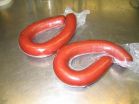(Press-News.org) Activity in areas of the brain related to reward and self-control may offer neural markers that predict whether people are likely to resist or give in to temptations, like food, in daily life, according to research in Psychological Science, a journal of the Association for Psychological Science.
"Most people have difficulty resisting temptation at least occasionally, even if what tempts them differs," say psychological scientists Rich Lopez and Todd Heatherton of Dartmouth College, authors on the study. "The overarching motivation of our work is to understand why some people are more likely to experience this self-regulation failure than others."
The research findings reveal that activity in reward areas of the brain in response to pictures of appetizing food predicts whether people tend to give in to food cravings and desires in real life, whereas activity in prefrontal areas during taxing self-control tasks predicts their ability to resist tempting food.
Lopez and colleagues used functional MRI (fMRI) to explore the interplay between activity in prefrontal brain regions associated with self-control (e.g., inferior frontal gyrus) and subcortical areas involved in affect and reward (e.g., nucleus accumbens), and to see whether the interplay between these regions predicts how successful (or unsuccessful) people are in controlling their desires to eat on a daily basis.
The researchers recruited 31 female participants to take part in an initial fMRI scanning session that included two important tasks.
For the first task, the participants were presented with various images, including some of high-calorie foods, like dessert items, fast-food items, and snacks. The participants were simply asked to indicate whether each image was set indoors or outdoors – the researchers were specifically interested in measuring activity in the nucleus accumbens in response to the food-related images.
For the second task, the participants were asked to press or not press a button based on the specific cues provided with each image, a task designed to gauge self-control ability. During this task, the researchers measured activity in the inferior frontal gyrus (IFG).
The fMRI scanning session was followed by 1 week of so-called "experience sampling," in which participants were signaled several times a day on a smartphone and asked to report their food desires and eating behaviors. Any time participants reported a food desire, they were then asked about the strength of the desire and their resistance to it. If they ultimately gave in to the craving, they were asked to say how much they had eaten.
As expected, participants who had relatively higher activity in the nucleus accumbens in response to the food images tended to experience more intense food desires. More importantly, they were also more likely to give in to their food cravings and eat the desired food.
The researchers were surprised by how robust this association was:
"Reward-related brain activity, which can be considered an implicit measure, predicted who gave in to temptations to eat, as well as who ate more, above and beyond the desire strength reported by participants in the moment," say Lopez and Heatherton. "This could help to explain a previous finding from our lab that people who show this kind of brain activity the most are also the most likely to gain weight over six months."
But brain activity also predicted who was more likely to be able to resist temptation: Participants who showed relatively higher IFG activity on the self-control task acted on their cravings less often.
When the researchers grouped the participants according to their IFG activity, the data revealed that participants who had high IFG activity were more successful at controlling how much they ate in particularly tempting situations than those who had low IFG activity. In fact, participants with low IFG activity were about 8.2 times more likely to give in to a food desire than those who had high IFG activity.
"Taken together, the results from the present study provide initial evidence for neural markers of everyday eating behaviors that can identify individuals who are more likely than others to give in to temptations to eat," the researchers write.
Lopez, Heatherton, and colleagues are currently conducting studies focused on groups of people who are especially prone to self-regulation failure: chronic dieters.
They're investigating, for example, how dieters' brains respond to food cues after they've exhausted their self-control resources. The researchers hypothesize that depleting self-control may heighten reward-related brain activity, effectively "turning up the volume on temptations," and predicting behaviors like overeating in daily life.
"Failures of self-control contribute to nearly half of all death in the United States each year," the researchers note. "Our findings and future research may ultimately help people learn ways to resist their temptations."
INFORMATION:
In addition to Lopez and Heatherton, co-authors include Wilhelm Hofmann of the University of Cologne and Dylan D. Wagner and William M. Kelley of Dartmouth College.
The research was supported by the National Institute on Drug Abuse of the National Institutes of Health under Award No. R01DA022582, by the National Heart, Lung, and Blood Institute under Award No. 1R21HL114092-01, by the National Cancer Institute under Award No. 1F31CA177203-01, and by the German Science Foundation (HO 4175/4-1).
For more information about this study, please contact: Richard Lopez at richard.b.lopez.gr@dartmouth.edu and Dr. Todd Heatherton at todd.f.heatherton@dartmouth.edu.
The article abstract is available online: http://pss.sagepub.com/content/early/2014/04/29/0956797614531492.abstract
The APS journal Psychological Science is the highest ranked empirical journal in psychology. For a copy of the article "Neural Predictors of Giving in to Temptation in Daily Life" and access to other Psychological Science research findings, please contact Anna Mikulak at 202-293-9300 or amikulak@psychologicalscience.org.
Individual brain activity predicts tendency to succumb to daily temptations
2014-05-01
ELSE PRESS RELEASES FROM THIS DATE:
Antimicrobial edible films inhibit pathogens in meat
2014-05-01
Antimicrobial agents incorporated into edible films applied to foods to seal in flavor, freshness and color can improve the microbiological safety of meats, according to researchers in Penn State's College of Agricultural Sciences.
Using films made of pullulan -- an edible, mostly tasteless, transparent polymer produced by the fungus Aureobasidium pulluns -- researchers evaluated the effectiveness of films containing essential oils derived from rosemary, oregano and nanoparticles against foodborne pathogens associated with meat and poultry.
The results demonstrate that ...
Researchers find the accelerator for molecular machines
2014-05-01
How hard can it be to make a wheel rotate in a machine? Very hard actually, when the wheel sits in one of those nano-small molecular machines that are predicted to be running our future machines. But before the molecular machines become part of our daily lives, researchers must be able to control them. A Danish/American research team have now solved part of this problem.
There are large machines and there are small machines - and then there are molecular machines. They are nano-tiny collections of molecular building blocks that together make up a machine and operate various ...
Unlocking a mystery of thalidomide
2014-05-01
In the 1950s and 1960s, pregnant women with morning sickness were often prescribed the new drug thalidomide. Shortly after the medicine was released on the market, a reported 10,000 infants were born with an extreme form of the rare congenital phocomelia syndrome, which caused death in 50 percent of cases and severe physical and mental disabilities in others. Although various factors are now known to cause phocomelia, the prominent roots of the disease can be found in the use of the drug thalidomide.
Now, half a century later, new research by Dr. Noam Shomron, Prof ...
New study suggests combination of statin and omega-3 fatty acid may provide cardioprotective effects
2014-05-01
Boston, MA-- New findings from an in vitro study, led by researchers at Brigham and Women's Hospital (BWH), show that the combination of statins and eicosapentaenoic acid (EPA), an omega-3 fatty acid, may potentially reduce cardiovascular risk. This research is being presented May 1 at a peer-reviewed poster session at the National Lipid Association Scientific Sessions in Orlando, Florida.
"We know that endothelial cell dysfunction is emerging as an early and important predictor of cardiovascular disease and plays an essential role in plaque development. Treatments that ...
Risk of weight gain deters some smokers from seeking treatment to quit
2014-05-01
Smokers may avoid treatment to quit smoking if they previously gained weight while trying to quit, according to researchers at Penn State College of Medicine.
Weight gain is a predictable occurrence for smokers who have recently quit. Within the first year after quitting, they gain an average of eight to14 pounds, and some smokers report that they keep smoking simply because they do not want to gain weight from quitting.
Susan Veldheer, project manager in the Department of Public Health Sciences, predicted that smokers would avoid treatment to quit if they are highly ...
Experimental drug prolongs life span in mice
2014-05-01
CHICAGO --- Northwestern Medicine® scientists have newly identified a protein's key role in cell and physiological aging and have developed – in collaboration with Tohoku University in Japan -- an experimental drug that inhibits the protein's effect and prolonged the lifespan in a mouse model of accelerated aging.
The rapidly aging mice fed the experimental drug lived more than four times longer than a control group, and their lungs and vascular system were protected from accelerated aging, the new study reports.
The experimental drug could potentially be used to treat ...
Researchers reveal new cause of epilepsy
2014-05-01
A team of researchers from SUNY Downstate Medical Center (SUNY Downstate) and Sanford-Burnham Medical Research Institute (Sanford-Burnham) has found that deficiencies in hyaluronan, also known as hyaluronic acid or HA, can lead to spontaneous epileptic seizures. HA is a polysaccharide molecule widely distributed throughout connective, epithelial, and neural tissues, including the brain's extracellular space (ECS). Their findings, published on April 30 in The Journal of Neuroscience, equip scientists with key information that may lead to new therapeutic approaches to epilepsy. ...
Algae 'see' a wide range of light
2014-05-01
VIDEO:
Land plants detect light with pigments called phytochromes, which are sensitive to red light. But red light is absorbed by water, so aquatic algae have evolved phytochromes with a much...
Click here for more information.
Aquatic algae can sense an unexpectedly wide range of color, allowing them to sense and adapt to changing light conditions in lakes and oceans. The study by researchers at UC Davis was published earlier this year in the journal Proceedings of the National ...
Climate change to intensify important African weather systems, Stanford scientists say
2014-05-01
Weather systems that bring rainstorms to many drought-prone areas of northern Africa, carry Saharan dust across the ocean and seed Atlantic hurricanes could grow stronger as a result of human-caused climate change, a new analysis by Stanford scientists suggests.
Known as African easterly waves, or AEWs, these weather systems form above northern Africa during the summer season and travel east to west, toward the Atlantic Ocean.
"Not only are AEWs important for rainfall in West Africa, they also play a role in climate across the Atlantic, including here in the United ...
When it comes to classes, small is better
2014-05-01
Small classes, especially in the first four years of school, can have an important and lasting impact on student achievement, a new report shows.
In a review of over 100 papers from 1979-2014, education expert Dr David Zyngier from Monash University's Faculty of Education looked at whether the conclusions reached on the effect of smaller class sizes still hold true today.
"The question of class size continues to attract the attention of educational policymakers and researchers alike," Dr Zyngier said.
"Many argue that much of Australia's increased expenditure on education ...

